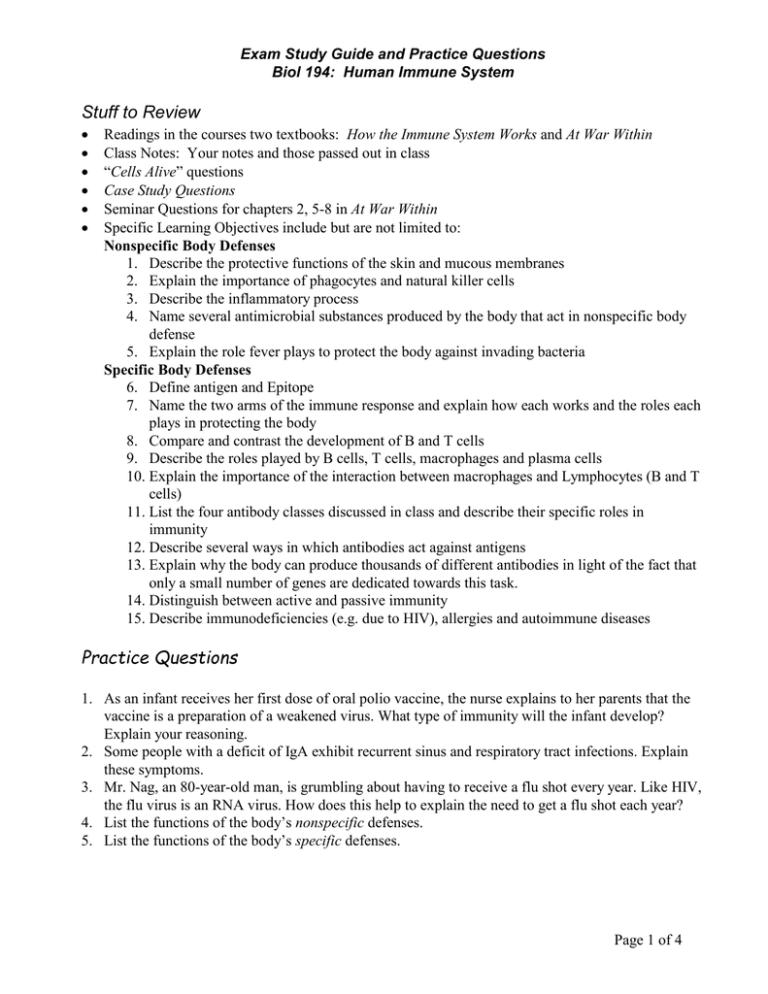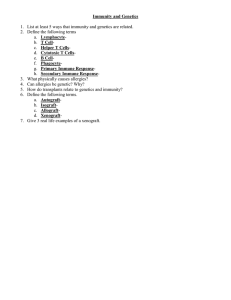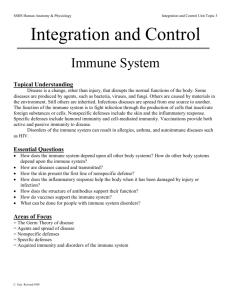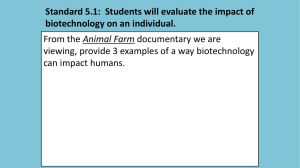Stuff to Review
advertisement

Exam Study Guide and Practice Questions Biol 194: Human Immune System Stuff to Review Readings in the courses two textbooks: How the Immune System Works and At War Within Class Notes: Your notes and those passed out in class “Cells Alive” questions Case Study Questions Seminar Questions for chapters 2, 5-8 in At War Within Specific Learning Objectives include but are not limited to: Nonspecific Body Defenses 1. Describe the protective functions of the skin and mucous membranes 2. Explain the importance of phagocytes and natural killer cells 3. Describe the inflammatory process 4. Name several antimicrobial substances produced by the body that act in nonspecific body defense 5. Explain the role fever plays to protect the body against invading bacteria Specific Body Defenses 6. Define antigen and Epitope 7. Name the two arms of the immune response and explain how each works and the roles each plays in protecting the body 8. Compare and contrast the development of B and T cells 9. Describe the roles played by B cells, T cells, macrophages and plasma cells 10. Explain the importance of the interaction between macrophages and Lymphocytes (B and T cells) 11. List the four antibody classes discussed in class and describe their specific roles in immunity 12. Describe several ways in which antibodies act against antigens 13. Explain why the body can produce thousands of different antibodies in light of the fact that only a small number of genes are dedicated towards this task. 14. Distinguish between active and passive immunity 15. Describe immunodeficiencies (e.g. due to HIV), allergies and autoimmune diseases Practice Questions 1. As an infant receives her first dose of oral polio vaccine, the nurse explains to her parents that the vaccine is a preparation of a weakened virus. What type of immunity will the infant develop? Explain your reasoning. 2. Some people with a deficit of IgA exhibit recurrent sinus and respiratory tract infections. Explain these symptoms. 3. Mr. Nag, an 80-year-old man, is grumbling about having to receive a flu shot every year. Like HIV, the flu virus is an RNA virus. How does this help to explain the need to get a flu shot each year? 4. List the functions of the body’s nonspecific defenses. 5. List the functions of the body’s specific defenses. Page 1 of 4 6. Complete the following statements concerning nonspecific defenses. a. The epidermis (skin) secretes __________ that functions to ________________. b. The epidermis acts as a barrier against __________________. c. The skin contains _________, which makes it resistant to acids, bases, and bacterial attack d. Mucus membranes trap microorganisms in the __________ and ____________. e. Cilia are located in the ______________ and function to _________________. 4. Although the eye provides a moist and warm environment, conditions that bacteria thrive in, eye infections are relatively rare. Why? 5. In what ways is the inflammatory response an important part of the body’s defense? 6. a. List the events of the inflammatory response in their correct order. b. What are the 4 cardinal signs of the inflammatory response? What is the cause of each? 7. Binding to antigens to receptors of immunocompetent lymphocytes leads to Clonal selection. Describe the process of Clonal selection. What kind of cell enhances the immune response and phagocytizes pathogens that have violated the first line of defenses? How do these cells enhance the immune response? What kind of cells do they interact with when enhancing the immune response? Discuss fully. 8. Name the kind of cell that is part of the nonspecific line of defense and lyses and kills cancerous and virus infected cells by the secreting perforin, a protein that punches holes in other cells. 9. What is the complement system of proteins and what do these proteins do? How is complement activated? 10. If a cell is infected by a virus it can often protect nearby cells from being killed by that virus. How is this done? 11. Discuss the immune system with respect to each of the following: a. Location within the body b. Specificity c. Time needed for a full response d. Memory 12. Under what circumstances will each of the following branches of the immune system be called into action? a. Cell-mediated immunity b Humoral immunity 13. Discuss B Cells (B lymphocytes) with respect to each of the following. a. Where they are produced b. Fate of B cells that bind to self-antigens c. Where they become immunocompetent d. How many different antigens each B Cell will respond to e. What is needed to stimulate a B cell to start dividing? f. Explain what happens once a B cell is stimulated to divide 14. Which type of cell(s) has the greatest ability to produce antibodies? 15. Which is more rapid, a primary or secondary immune response? Explain your reasoning. 16. Name the four classes of immunoglobulins discussed in class. Which is the most abundant in blood plasma? Which is important in allergic responses? Which is the 1st to be released during a primary immune response? Which can cross the placenta? 17. Define allergy and distinguish between immediate and delayed hypersensitivities. How are they similar? Different? What is the cause of each? How do they occur? Why are some allergies treated with antihistamines and others treated with corticosteroid drugs? 18. What are possible causes in the loss of self-tolerance and autoimmune diseases? Page 2 of 4 19. Discuss T Cells (T lymphocytes) with respect to each of the following. a. Where they are produced b. Fate of T cells that bind to self-antigens c. Where they become immunocompetent d. How many different antigens each T Cell will respond to e. What is needed to stimulate a T cell to start dividing (answer w.r.t. both helper and killer T cells) f. What the end result is once a T cell is stimulated to divide (answer w.r.t. both helper and killer T cells) 20. Suppose a pathogen infects and kills macrophage cells. How will this pathogen affect B Cell activity? T Cell activity? The ability to produce a fever? 21. Of what benefit is a fever during a bacterial infection? 22. Discuss antibodies with respect to each of the following: a. Specificity b. Shape c. How many different kinds can a single B cell produce when activated? d. How many different antibodies is the body capable of producing? Why e. Location of the antigens they respond to f. Class involved with the allergic response (immediate hypersensitivities) 23. What role(s) do macrophages play when tissue is damaged as a result of a cut? 24. Distinguish between: a. Humoral immunity and cell mediated immunity b. Passive immunity and active immunity c. Pyrogens and Interferons d. B cells, plasma cells, and memory cells e. NK cells (natural killer cells), macrophages, and neutrophils 25. How do the following provide evidence for a link between the mind and the immune system? a. Observations of twin sisters, one with rheumatoid arthritis, the other without (See Clarks’ At War Within, pages 224-226) a. Robert Ader’s experiments with mice (See Clarks’ At War Within, page 228) and the immunosuppressant drug cyclophosphamide (CP) b. Observations of women undergoing chemotherapy for ovarian cancer (See Clarks’ At War Within, page 229) c. Good’s experiments with allergens and hypnotized subjects (See Clarks’ At War With in, page 230) 26. A patient that requires daily injections of insulin to control his diabetes is found to have circulating antibodies that attack the insulin producing cells in the patient’s pancreas. What is the cause of diabetes in this patient? 27. The major symptoms of many allergies are a runny nose, watery eyes, reddened skin, and itching. Explain the cause of each. 28. Why can the symptoms of food allergies manifest themselves almost anywhere in the body, whereas the symptoms of many other allergies (e.g. asthma, hay fever, etc.) are more localized? 29. The following questions refer to Clark’s books, At War Within. Page 3 of 4 30. a. Why will serum taken from a rabbit previously exposed to a mild dose of tetanus causing bacteria protect another rabbit from a potentially lethal dose of the tetanus exotoxin? (See p. 36) b. What is the significance of the experiments conducted with the bursectomized chicks? (See pp. 41-43) c. How do CD8 T cells (i.e. Killer or Cytotoxic T cells) destroy cancerous, damaged, and infected cells? What role does the p53 gene (suicide gene responsible for apoptosis) play? (Pp.43-44) d. Cancer patients are treated with radiation and/or chemotherapeutic drugs in an effort to destroy the cancerous tissue. Unfortunately, both methods of treatment suppress the immune system. Why? (See pages 52-53) e. Why will the second injection of a small amount of egg white protein into the circulatory system kill a person, but the eating of egg white will not? (See pages 83-87) f. Need to brush up on immediate hypersensitivities? See Pages 87-100 Page 4 of 4




